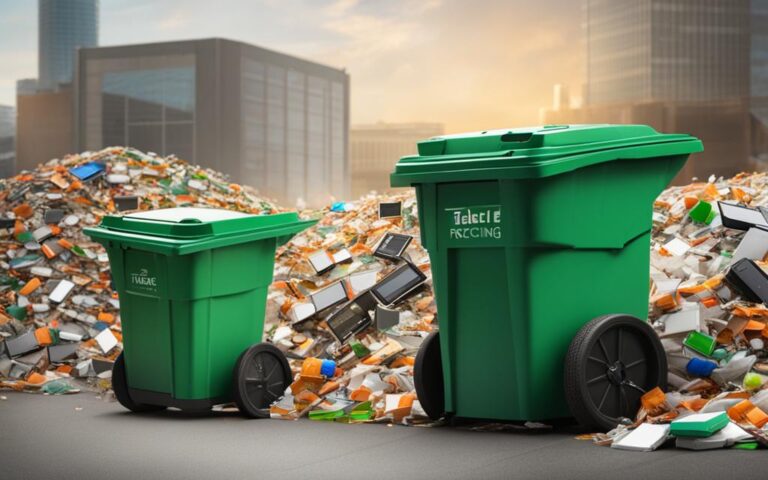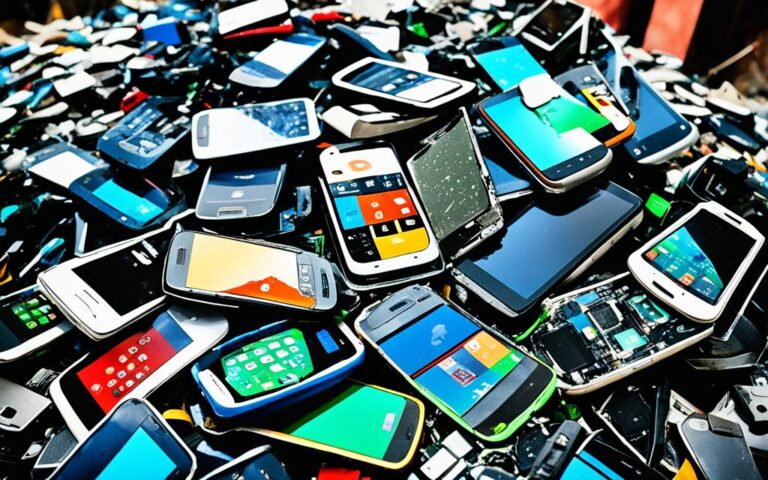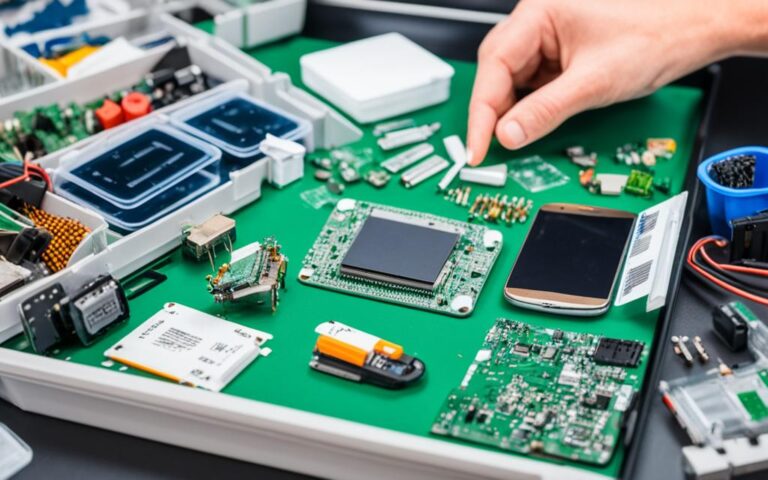How Recycled Mobile Phones Contribute to New Products
In a world where technological advancements are rapidly shaping our future, the sustainability of our devices is a pressing concern. In this article, we explore the transformative power of recycled mobile phones and their role in shaping new products that align with our shared vision of a greener tech industry.
As the world’s leading smartphone manufacturers, Apple and Samsung are paving the way towards a more sustainable future. Both companies are increasingly incorporating recycled materials into their products, revolutionizing the way we think about mobile phones.
Apple, for instance, used 45% certified recycled rare earth elements in its products in 2021, with the goal of eventually creating iPhones entirely from recycled materials. Similarly, Samsung aims to incorporate recycled resin into 100% of the plastics in its devices by 2050. These efforts not only reduce electronic waste but also help minimize the carbon footprint of our beloved gadgets.
By embracing the use of recycled materials, Apple and Samsung are not only addressing consumers’ growing concerns about environmental impact but also leading the charge in shaping a more sustainable tech industry. Their commitment to sustainability sets a powerful example for the entire sector.
Join us as we delve deeper into the ambitions, challenges, and triumphs of recycling mobile phones in the sections that follow. Together, we can unlock the potential of recycled mobile phones and pave the way for a brighter future where innovation and sustainability coexist harmoniously.
Ambitions and Challenges of Recycling Mobile Phones
As the world becomes more aware of the environmental impact of electronic waste, the ambitions of tech giants like Apple and Samsung are growing to create a more sustainable future. However, achieving a phone made completely from recycled materials is no easy feat.
Recycling mobile phones involves rethinking the entire supply chain and materials used for critical components. It requires innovative approaches to sourcing, manufacturing, and assembly. Apple and Samsung have already made progress in incorporating recycled materials into their devices, but scaling these efforts industry-wide poses significant challenges.
To overcome these challenges, collaboration between tech companies is vital. By establishing common standards for device specifications, companies can work together to drive sustainability across the industry. The European Union (EU) has already taken steps in this direction, mandating USB-C charging as a requirement for smartphones. This move fosters ubiquity, reducing additional waste from different charging cables.
Furthermore, companies like Apple and Samsung are actively making their sustainable technologies available to others through licensing and open-sourcing. This approach encourages industry-wide adoption of eco-friendly practices and fosters innovation in recycling processes.
The Role of Collaboration
“Collaboration is key in overcoming the challenges of recycling mobile phones and building a more sustainable tech industry. By sharing knowledge, resources, and best practices, companies can drive change and accelerate the transition to a circular economy.” – Tim Cook
Through collaboration, the tech industry can collectively tackle the complex issues associated with recycling mobile phones. This includes finding innovative solutions for recycling critical components, such as batteries, screens, and circuit boards. It also involves developing efficient and environmentally friendly methods for recovering valuable materials from discarded devices.
Customer Expectations and Industry Standards
“Customers are increasingly demanding sustainable products, and it is our responsibility as industry leaders to meet these expectations. By setting high standards for ourselves and working together, we can drive positive change and create a more sustainable future.” – DJ Koh
With consumer demand for eco-conscious products on the rise, there is a clear incentive for tech companies to prioritize sustainable practices. By meeting customer expectations, companies can not only attract environmentally conscious consumers but also differentiate themselves in the market.
However, to achieve widespread adoption and impact, industry-wide standards need to be established. These standards would ensure consistency and transparency in recycling processes, materials sourcing, and product lifecycle. They would also facilitate the development of a closed-loop recycling system, where materials from old devices are efficiently recovered and reused in new products.
By overcoming the ambitions and challenges of recycling mobile phones, the tech industry can pave the way for a more sustainable future. Collaboration, innovation, and adherence to industry standards will be crucial in reducing electronic waste and creating a circular economy for electronic devices.
Apple and Samsung’s Efforts in Sustainability
Apple and Samsung, two industry-leading tech giants, are setting an inspiring example when it comes to sustainability. Both companies have recognized the importance of incorporating recycled materials into their products to reduce waste and lessen their environmental impact. Let’s take a closer look at the sustainability initiatives undertaken by Apple and Samsung:
Apple: Paving the Way to a Carbon Neutral Future
Apple has set ambitious goals to achieve a 100% carbon neutral supply chain and product line by 2030. As part of their commitment to sustainability, they have already begun incorporating recycled rare earth elements and other recycled materials into their devices. By 2022, Apple aims to use 100% recycled tin in the solder of their main logic boards. These efforts not only reduce the carbon footprint of their products but also help conserve valuable natural resources.
Samsung: Innovating for a Greener Future
Samsung is also dedicated to sustainability. By 2030, they aim to make their devices more energy efficient and incorporate recycled resin into 50% of their plastic parts. This commitment to using recycled materials helps to close the loop on plastic waste and contribute to a more circular economy. Samsung’s investments in research and development for materials recovery and recycling processes ensure that they stay at the forefront of sustainable technology.
Through the efforts of Apple and Samsung, the tech industry is witnessing a shift towards more sustainable practices. By incorporating recycled materials into their products, these companies are not only reducing their own environmental impact but also inspiring others to follow suit.
“We believe that by using more recycled materials and reducing our carbon footprint, we can make a positive impact on the planet and create a better future for generations to come.” – Apple
Apple and Samsung’s commitment to sustainability goes beyond their individual efforts. They are actively collaborating with other tech companies, sharing their sustainable technologies and processes through licensing and open-sourcing. By working together, they aim to establish common standards for the industry, making sustainable practices the norm rather than the exception.
Their dedication to sustainability not only benefits the environment but also resonates with consumers who are increasingly conscious of the impact their purchasing decisions have on the planet. As Apple and Samsung continue to innovate and lead by example, they pave the way for a more sustainable future for the entire tech industry.
The Importance of Extending Smartphone Lifespan
Extending the lifespan of smartphones is crucial for reducing e-waste and conserving resources. By keeping phones in use for longer, we can significantly decrease carbon emissions and contribute to a more sustainable future.
Manufacturers play a vital role in promoting smartphone longevity. Designing phones with repairability in mind is key. This means creating devices that allow for individual component replacement. When a single part malfunctions, users shouldn’t have to replace the entire phone. Instead, they should have the option to repair or replace the faulty component, extending the overall lifespan of the device.
Fortunately, the market is responding to this need. Third-party repair services and marketplaces are emerging, providing consumers with reliable and affordable repair options. These services offer an alternative to manufacturer repairs, ensuring that users have access to cost-effective solutions for common smartphone issues.
“Extending the lifespan of a smartphone by just one year can save the same amount of carbon emissions produced by powering a household for six months.”
Governments also have an important role to play in incentivizing repairs. Measures such as tax incentives and regulations like the EU’s “Right to repair” encourage consumers to prioritize repairs over replacements. By reducing the financial barriers associated with repairs and creating a supportive policy environment, governments can promote a circular economy for smartphones, minimising e-waste and conserving valuable resources.
Moreover, shifting from traditional ownership models to leasing or subscription-based services can further reduce the number of phones in use. With these models, users can upgrade to newer devices without discarding their old ones. The returned devices can then be refurbished and reissued, extending their lifespan and reducing overall waste.
Separating personal and business functionality is another strategy for reducing e-waste. Instead of carrying separate personal and business phones, individuals can use a single device with the ability to toggle between different modes. This approach not only reduces the number of phones in circulation but also streamlines operations and enhances efficiency.
The Impact of Extending Smartphone Lifespan
The benefits of extending the lifespan of smartphones go beyond reducing e-waste. It also contributes to a circular economy for electronic devices. By keeping phones in use for longer, we conserve valuable resources and reduce dependency on raw materials extraction.
In addition, promoting repairability and extending the lifespan of smartphones fosters a more sustainable and responsible consumer culture. It encourages individuals to value and care for their devices, shifting away from a throwaway mindset. Repair becomes a viable option, empowering users to take control of their devices’ lifecycle and embrace sustainability.
By extending smartphone lifespan, we can reshape the way we consume and discard electronic devices. It is a critical step towards building a more sustainable future, reducing e-waste, and embracing the principles of the circular economy.
Ways to Extend Smartphone Lifespan:
- Protect your phone with a durable case and screen protector to prevent damage.
- Regularly update your smartphone’s software to ensure it remains secure and functional.
- Optimize battery usage by adjusting settings and limiting background app refresh.
- Clean your device regularly to remove dirt and debris that can affect performance.
- Consider using a battery replacement service when your phone’s battery starts to degrade.
- Back up your data regularly to prevent loss in case of hardware failure.
The Role of Repair in Circular Economy for Electronics
Repairing electronics, including smartphones, plays a crucial role in building a circular economy. By extending the lifespan of devices through effective repairs, we can reduce electronic waste and promote sustainability in the tech industry. Manufacturers like Fairphone are leading the way in producing repairable and upgradeable smartphones, prioritizing longevity over obsolescence.
A modular design approach allows for the swapping out of malfunctioning parts, ensuring that individual components can be replaced rather than the entire device. This not only minimizes waste but also reduces the cost of repairs for consumers, making repair a more viable option than replacement.
The “Right to repair” movement is gaining momentum, advocating for access to affordable and convenient repairs, including essential software upgrades. Governments are recognizing the importance of repairability and transparency, leading to the implementation of regulations that support consumers’ rights to repair their electronics.
Financial incentives, such as tax incentives for repairs, are being introduced to encourage individuals to choose repair over disposal. These initiatives aim to create a more sustainable and resource-efficient circular economy for electronics.
All stakeholders, including producers, governments, and consumers, must work together to make repair a central focus in the circular economy for electronics. By embracing repairability and extending the lifespan of electronic devices, we can reduce waste, conserve resources, and contribute to a more sustainable future.
Benefits of Repair in the Circular Economy:
- Reduces electronic waste and conserves resources
- Minimizes the carbon footprint of electronics
- Provides more affordable repair options for consumers
- Promotes transparency and consumer rights
- Supports the development of a sustainable tech industry
Challenges and Solutions:
“One of the key challenges in implementing repair in the circular economy is the complex design and integration of components in electronic devices. However, companies like Fairphone are leading by example, demonstrating that repairable smartphones are not only possible but also desirable. By prioritizing repairability in product design and collaborating with repair service providers, manufacturers can ensure that repairing electronics becomes a mainstream practice.”
Government Regulations and Incentives:
| Initiative | Description |
|---|---|
| Right to Repair Legislation | Governments are introducing laws to enforce manufacturers to provide access to repair information, tools, and spare parts to consumers and third-party repair services. |
| Tax Incentives for Repairs | Financial incentives, such as tax breaks or reduced VAT rates, are offered to individuals and businesses for choosing repair services instead of buying new devices. |
| Repairability Index | Some countries are proposing the introduction of a repairability index that rates electronic devices based on their ease of repair, encouraging manufacturers to prioritize repairability in product design. |
By implementing supportive regulations and offering financial incentives, governments can accelerate the adoption of repair practices and create a more sustainable circular economy for electronics.
Changing Business Models and Consumer Habits
As we move towards a more sustainable future, it’s crucial for businesses and consumers to embrace changing models and habits that support the circular economy. This shift is essential for reducing waste, conserving resources, and creating a more environmentally friendly tech industry.
Shifting Business Models: From Linear to Circular
Traditional business models follow a linear approach, where products are used and discarded after their lifespan. However, in the circular economy, materials are kept in circulation, reducing the need for raw resources and minimizing waste. One way businesses can facilitate this transition is by leasing phones rather than selling them.
“Leasing allows manufacturers to recover and refurbish materials, reducing the environmental impact.”
In addition to leasing, deposit schemes can incentivize the return of purchased phones, ensuring that materials can be reused or recycled properly. Phone-as-a-service models also play a significant role in the circular economy, offering regular upgrades while ensuring the return of old devices for refurbishment.
Consumer Habits: Embracing Change for a Sustainable Future
Consumers have a crucial role to play in driving the circular economy. Embracing longer phone lifespans and prioritizing repairs over replacements is essential for reducing e-waste and conserving resources. By extending the lifespan of smartphones, carbon emissions can be significantly reduced.
Government support is vital in driving these changes. Regulations and tax incentives can encourage businesses and consumers to adopt more sustainable practices. By creating a supportive environment, governments can help accelerate the transition to a circular economy.
It’s time for businesses and consumers alike to recognize the importance of changing business models and habits to support the circular economy. Together, we can contribute to a greener and more sustainable tech industry for generations to come.
| Business Models | Consumer Habits |
|---|---|
| Leasing phones | Embracing longer phone lifespans |
| Deposit schemes | Prioritizing repairs over replacements |
| Phone-as-a-service models | Supporting refurbishment initiatives |
Conclusion
Recycled mobile phones have the power to revolutionize the tech industry and pave the way for a more sustainable future. Industry leaders like Apple and Samsung are already taking the lead in incorporating recycled materials into their devices. However, to truly make a significant impact, scaling these efforts industry-wide is crucial.
It is imperative that we extend the lifespan of smartphones and prioritize repairs to tackle the growing e-waste problem and conserve valuable resources. By designing phones with repairability in mind, allowing for individual component replacement, we can ensure that devices stay in use for longer periods. Third-party repair services and marketplaces are also emerging, providing consumers with reliable and affordable repair options.
Shifting from linear business models to circular ones is also essential in building a more sustainable tech industry. Leasing models, deposit schemes, and phone-as-a-service offerings allow for the recovery and refurbishment of materials, reducing the need for constant device replacements. Consumers, too, must embrace longer phone lifespans and prioritize repairs over replacements to contribute to a circular economy for electronics.
Government support in the form of regulations and tax incentives can play a significant role in driving these changes. By enforcing regulations that promote repairability and transparency, governments can encourage manufacturers to design products with the circular economy in mind. Tax incentives for repairs can also incentivize consumers to choose repair options over purchasing new devices.
With the collaboration of all stakeholders, including tech companies, governments, and consumers, the potential of recycled mobile phones can be harnessed to build a greener and more innovative industry. By embracing the ideals of sustainability and circularity, we can transform the tech landscape and create a better future for generations to come.
FAQ
How do recycled mobile phones contribute to new products?
Recycled mobile phones have the potential to contribute to new products and shape a more sustainable future. By incorporating recycled materials into devices, manufacturers like Apple and Samsung are reducing waste and the carbon footprint of their products. These materials can be recovered and used in the production of new items, further promoting sustainability in the tech industry.
What are the ambitions and challenges of recycling mobile phones?
Recycling mobile phones comes with ambitions and challenges. The goal is to achieve a circular economy where materials are kept in circulation, reducing the need for raw resources. However, achieving this requires rethinking supply chains and materials used for critical components. Scaling recycling efforts industry-wide is a monumental task, but collaboration between tech companies, common standards, and government support can help overcome these challenges.
What efforts are Apple and Samsung making in sustainability?
Apple and Samsung are leading the way in making their tech products more sustainable. Apple aims to achieve a 100% carbon-neutral supply chain and product line by 2030. They have already incorporated recycled rare earth elements and other recycled materials into their devices. Samsung’s goals include making their devices more energy efficient and incorporating recycled resin into 50% of their plastic parts by 2030. Both companies are investing in research and development to improve materials recovery and recycling processes.
Why is extending smartphone lifespan important?
Extending the lifespan of smartphones is crucial for reducing e-waste and conserving resources. Even just increasing the lifespan of a smartphone by one year can significantly decrease carbon emissions. This can be achieved by designing phones with repairability in mind, allowing for individual component replacement. Third-party repair services, government incentives, and a shift towards leasing models can all contribute to prolonging the lifespan of smartphones.
What is the role of repair in the circular economy for electronics?
Repair plays a crucial role in building a circular economy for electronics. Modular design allows for the swapping out of malfunctioning parts, extending the life of the device. Manufacturers like Fairphone are leading the way in producing repairable and upgradeable smartphones. The “Right to repair” movement advocates for access to affordable and convenient repairs, including software upgrades. Governments are implementing regulations to encourage repairability and transparency, while financial initiatives like tax incentives support repair efforts.
How can changing business models and consumer habits contribute to the circular economy?
Shifting business models from linear to circular, where products are reused and materials are kept in circulation, is essential. Leasing phones instead of selling them allows for recovery and refurbishment of materials. Deposit schemes incentivize the return of purchased phones, while phone-as-a-service models enable regular upgrades and device return for refurbishment. Consumers embracing longer phone lifespans and prioritizing repairs over replacements further contribute to the circular economy. Government support through regulations and tax incentives can help drive these changes.















